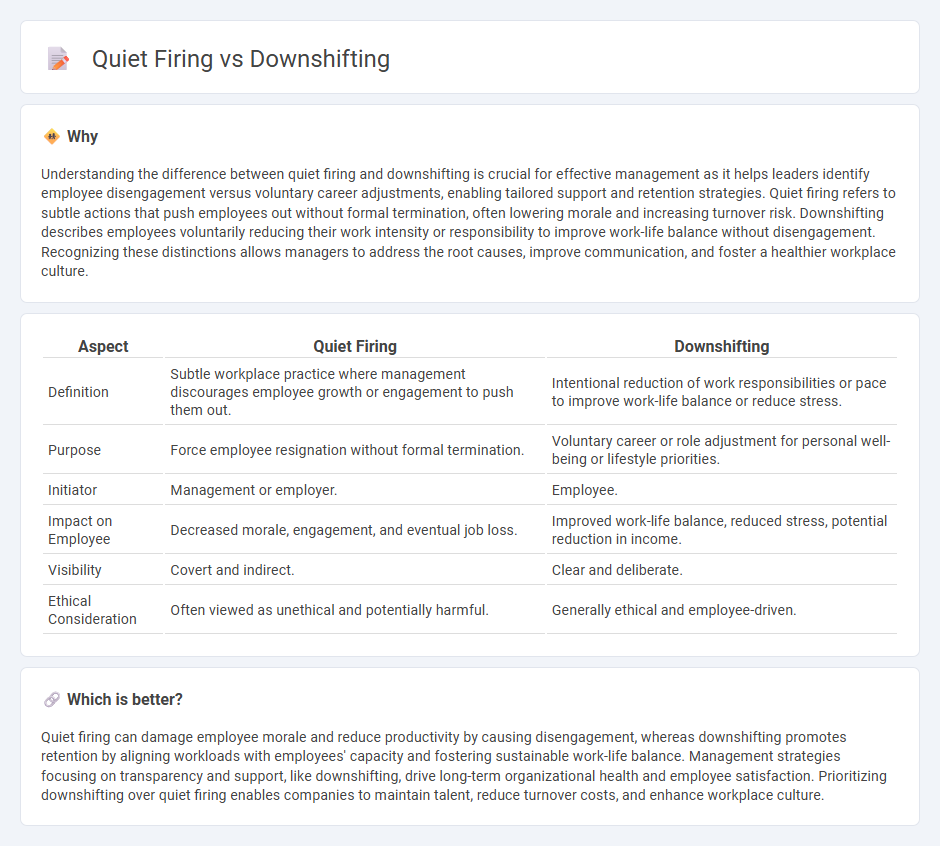
Quiet firing refers to subtle employer tactics that encourage an employee to leave without formal termination, often through reduced responsibilities or lack of support. Downshifting involves an employee willingly reducing work hours or responsibilities to achieve better work-life balance or lower stress levels. Explore the nuances and implications of quiet firing versus downshifting in modern management practices to make informed decisions.
Why it is important
Understanding the difference between quiet firing and downshifting is crucial for effective management as it helps leaders identify employee disengagement versus voluntary career adjustments, enabling tailored support and retention strategies. Quiet firing refers to subtle actions that push employees out without formal termination, often lowering morale and increasing turnover risk. Downshifting describes employees voluntarily reducing their work intensity or responsibility to improve work-life balance without disengagement. Recognizing these distinctions allows managers to address the root causes, improve communication, and foster a healthier workplace culture.
Comparison Table
| Aspect | Quiet Firing | Downshifting |
|---|---|---|
| Definition | Subtle workplace practice where management discourages employee growth or engagement to push them out. | Intentional reduction of work responsibilities or pace to improve work-life balance or reduce stress. |
| Purpose | Force employee resignation without formal termination. | Voluntary career or role adjustment for personal well-being or lifestyle priorities. |
| Initiator | Management or employer. | Employee. |
| Impact on Employee | Decreased morale, engagement, and eventual job loss. | Improved work-life balance, reduced stress, potential reduction in income. |
| Visibility | Covert and indirect. | Clear and deliberate. |
| Ethical Consideration | Often viewed as unethical and potentially harmful. | Generally ethical and employee-driven. |
Which is better?
Quiet firing can damage employee morale and reduce productivity by causing disengagement, whereas downshifting promotes retention by aligning workloads with employees' capacity and fostering sustainable work-life balance. Management strategies focusing on transparency and support, like downshifting, drive long-term organizational health and employee satisfaction. Prioritizing downshifting over quiet firing enables companies to maintain talent, reduce turnover costs, and enhance workplace culture.
Connection
Quiet firing, where employers deliberately underutilize or isolate employees, often leads to downshifting, characterized by a voluntary reduction in work intensity or responsibilities by those employees. This subtle organizational behavior impacts employee engagement and productivity, prompting individuals to recalibrate their career goals and work-life balance. Understanding the interplay between quiet firing and downshifting is crucial for effective talent management and retaining skilled workforce.
Key Terms
Work-Life Balance
Downshifting prioritizes reducing work hours or responsibilities to enhance personal well-being and achieve a healthier work-life balance, often by choosing less stressful jobs or part-time roles. Quiet firing involves employers subtly pushing employees out by cutting opportunities, resources, or support without formal termination, negatively impacting morale and work-life balance. Explore more about how these contrasting workplace trends affect your professional and personal life.
Employee Engagement
Downshifting in the workplace involves employees intentionally reducing their workload or responsibilities to achieve better work-life balance, which can enhance employee engagement by promoting well-being and job satisfaction. Quiet firing, on the other hand, refers to employers subtly pushing employees out by reducing opportunities, support, or resources, negatively impacting engagement and morale. Explore how these contrasting approaches affect your organization's employee engagement strategies and outcomes.
Organizational Culture
Downshifting reflects a conscious organizational culture shift toward work-life balance, emphasizing employee well-being and reduced stress. Quiet firing indicates a toxic culture where management subtly forces disengagement without transparency, damaging trust and morale. Explore how fostering a transparent environment can prevent quiet firing and promote authentic downshifting practices.
Source and External Links
How to Drive a Manual Vehicle With Down Shifting - This guide provides instructions on how to downshift smoothly in a manual vehicle, including techniques like rev-matching to prevent engine stalling.
Downshifting: Simple Living - Downshifting involves adopting a simpler lifestyle by reducing materialism and focusing on personal fulfillment, often through voluntary simplicity.
The Downshifting Secret Every Rider Should Know - This video explains the technique of "blip shifting" for smoother downshifting, which involves rev-matching to avoid jerks and improve control.
 dowidth.com
dowidth.com